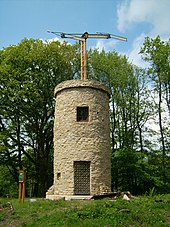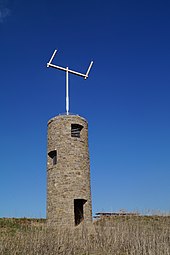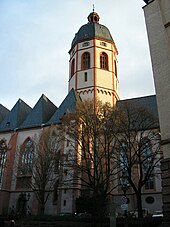Optical telegraph line Metz – Mainz
| Optical telegraph line from Metz to Mainz | |||||||||||||||||||||||||||||||||||||||||||||||||||||||||||||||||||||||||||||||||||||||||||||||||||||||||||||||||
|---|---|---|---|---|---|---|---|---|---|---|---|---|---|---|---|---|---|---|---|---|---|---|---|---|---|---|---|---|---|---|---|---|---|---|---|---|---|---|---|---|---|---|---|---|---|---|---|---|---|---|---|---|---|---|---|---|---|---|---|---|---|---|---|---|---|---|---|---|---|---|---|---|---|---|---|---|---|---|---|---|---|---|---|---|---|---|---|---|---|---|---|---|---|---|---|---|---|---|---|---|---|---|---|---|---|---|---|---|---|---|---|---|---|
|
|||||||||||||||||||||||||||||||||||||||||||||||||||||||||||||||||||||||||||||||||||||||||||||||||||||||||||||||||
The optical telegraph line from Metz to Mainz was opened on May 29, 1813.
This made it the first optical telegraph line that ran in an area that is now largely within the borders of the Federal Republic of Germany , but within the borders of that time it ran completely through the French Empire . It was created as a route extension of the Paris - Metz line .
The telegraphic communication system , which existed until mid-January 1814, was used for official and military communication by means of optical signals over a distance of almost 225 kilometers (in a direct line). The telegraph line consisted of up to 22 telegraph stations that were equipped with signal masts. The stations were equipped with telescopes with which telegraph operators read specially coded information from a signaling station and passed this on immediately to the next one.
The facility was interrupted to Mainz on New Year's Eve 1814, when the Yorck Corps , an advance guard under General Field Marshal Blücher , reached Kreuznach . About two weeks later operations were completely stopped due to the siege of Mainz .
Historical background
Based on the design by Claude Chappe and his brothers, optical-mechanical telegraphy was used in France as early as August 1794 on the Paris – Lille line . On November 22, 1794, the Karlsruhe physics professor Johann Lorenz Boeckmann sent his margrave Karl Friedrich von Baden a congratulatory telegram of 200 letters to the Karlsruhe Palace using the system of the optical telegraph of the priest Claude Chappe. Claude Chappe's younger brother Abraham, who built the Paris – Lille line, extended it to Dunkirk in 1798 , to Boulogne-sur-Mer in 1801 , to Antwerp and Vlissingen in 1809 and finally to Amsterdam in 1810 . From January 1798 a second line was built into Alsace , which already connected Strasbourg , Metz and Chalons with Paris on May 31st of that year . The reason for the construction was not least the Rastatt Congress (1797 to 1799), at which the French envoy was dependent on the ongoing exchange of information with Paris.
The branch to Mainz was needed to connect the capital of the Donnersberg department , an area annexed by the French and taken over into the departmental division in 1798.
After the Mainz line was destroyed by the Prussians, it took 18 years before they began using optical telegraphy on a state-run Prussian telegraph line from Berlin to Koblenz from 1832 onwards. While Sweden , Denmark and England emulated the French model much earlier, the small and sub-states existing on German territory showed no interest in a communication technology that transcended their own territory, nor were there the political conditions for the necessary agreements and arrangements.
Transmission speed
In 1794, a message between two minutes and six minutes could be transmitted for the roughly equal distance of about 225 kilometers from Paris to Lille with 25 telegraph stations.
Stations


Reconstructions
A reconstruction of the Chappe signal mast was erected on the Hoxberg in 1973, which was also on a special stamp.
In 2014, a tower ( Napoleon Tower ) was built on the Napoleonshöhe northeast of Sprendlingen , which is intended as a " technological historical monument " to commemorate the beginnings of long-distance communications and also serves as a viewing tower .
The signal arms on the tower correspond to the Chappe system, but for safety reasons were not equipped with movable, but fixed pointers. The direction markings on the viewing platform point to the former locations of the neighboring towers Hungriger Wolf near Bad Kreuznach (towards Metz) and Heidenhof near Schwabenheim an der Selz (towards Mainz).
See also
literature
- Holger Umkehr: From bronze wire to fiber optic cable - modern transmission technologies . Part 1. In: WissenHeute , 11/2004
- Thomas Wagner: Amateur radio - a radio service for experiments and worldwide communication . In: Deutsche Telekom instruction sheets, year 52, 4/1999, p. 205
- Birgit-Susann Mathis: Everyday life of the telegraph operator . In: As far as the eye can see: The history of optical telegraphy. ISBN 3-7650-8150-7 (publication by the Museum for Post and Communication , Frankfurt am Main, on the occasion of the exhibition of the same name from April 27 to July 30, 1995)
- Hans Pieper: From the history of communications technology from antiquity to the present - with special consideration of optical telegraphy in France and Prussia . In: The Cologne-Flittard telegraph station. A little history of communications engineering . Rheinisch-Westfälisches Wirtschaftsarchiv zu Köln, Cologne 1973, pp. 21–58, ISBN 3-933025-19-2
- 80 or 75 years Telegraphenamt Mainz . In: Deutsche Verkehrs-Zeitung - weekly for the post, telegraph, telephone and radio system , 53rd year, August 31, 1929, edition A, no. 35, pp. 639–640
Web links
- Metz-Mainz-Timeline , German Telephone Museum in Morbach
- Optical telegraph stations in Saarland
- Napoleon storm Sprendlingen
- First telegraph line on German soil
- telegraphe-chappe.com (French)
- telegraphe-chappe.eu (French)
Individual evidence
- ↑ Historical data (content of the website has completely changed. The page www.knorscheid-hoxberg.de/html/opttel1.html is therefore no longer available)
- ↑ Hans Pieper: From the history of communications technology from antiquity to the present , pp. 35–36
- ↑ Dieter Herbarth: The development of optical telegraphy in Preussen , p. 19ff, p. 34
- ↑ Thomas Wagner, p. 205
- ↑ Holger Umkehr, p. 610
- ^ Napoleon storm on the website of the Verbandsgemeinde Sprendlingen-Gensingen


